Homage Lytton Springs – the land, the people, the wine, by Allan Bree
Evocation
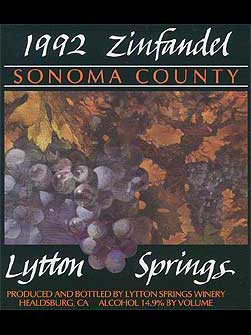 Sometimes a single smell can conjure recollections so profound as to transport you back to a particular time and place. A song can beam you back to your teens, dancing with your high school honey. A flavor can carry you away to the house you grew up in, sitting down to one of mom’s dinners.
Sometimes a single smell can conjure recollections so profound as to transport you back to a particular time and place. A song can beam you back to your teens, dancing with your high school honey. A flavor can carry you away to the house you grew up in, sitting down to one of mom’s dinners.
And for those of us with the oenophilic affliction, the mere mention of a wine can fill the nose and coat the palate with aroma and flavor memories so distinct that you could swear you had the glass in your hand and the bottle within reach. The wine becomes the place where the vines grow; the place becomes the wine.
When it comes to Zinfandel, there are only two that convey such powerfully suggestive remembrance, that speak so eloquently of their origin, that blend the wine, the place and the memories into a single entity. Geyserville is one.
The other is Lytton Springs.
Evolution
A brief history of the property
Captain Henry Delano Fitch was a native of New Hampshire and came to California in 1833 or so, where he commanded merchant ships that traded along the California coast. While in San Diego in 1837 or so, he became smitten with Josefa Carillo. Jose Maria Echeandia, the Governor at the time, was also interested in the girl, and prevented her and Fitch from marrying. They eloped to South America, returning almost a year later with an infant son.
General Mariano Vallejo, who first settled the lands north of San Francisco soon married Josefa’s younger sister, and H. D. Fitch became his brother-in-law. This would result in Fitch’s acquisition of the land grant known as Rancho Sotoyome, consisting of 11 square leagues – more than 48,800 acres.
Fitch promptly hired Cyrus Alexander to manage the Rancho. Alexander was given 9000 acres as payment for his services, and chose the magnificent valley east of the Russian River that now bears his name.
Fitch died in 1848, and after the United States Government legitimized the early land grants in 1858, his widow began auctioning parcels of the property in order to meet her family’s expenses.
In 1860 an American sea captain acquired a large tract north of what would become the town of Healdsburg. The property extended from the northern boundaries of Healdsburg to the southern boundaries of Geyserville, and from the Russian River to the Dry Creek.
The sea captain’s name was William H. Litton.
Litton and his partners decided to capitalize on the improved transportation. They built a resort hotel in 1875 on a site that contains both a soda spring and a sweet water spring. The hotel, able to accommodate 150 guests became known as Litton Springs, the nearby train depot was called Litton Station.
In 1887, Captain Litton died from head injuries sustained in a fall from a buggy, and his family, no longer interested in maintaining the resort, allowed it to become a military academy for the sons of wealthy Bay Area families.
Three years later, in 1890, despite winning a lawsuit against him for water rights, Mrs. Litton lost control of the property to James Donahue, who was developing Litton Township, just east of the railroad he built. Ironically, he died that year. As part of the settlement of his estate, the property was sold to Charles H. Montgomery in 1893, who sold it to a Dr. Burke from Oakland, who planned to operate a sanitarium on the site.
Later, in 1898, a portion of the property – 712 acres – was sold to George S. Montgomery and A. W. Dennett, a restaurateur from San Francisco. They planned to keep the sanitarium concept alive, augmenting its attraction with Bible courses.
Somehow, whether by accident or design, the spelling of the property’s name was changed around this time by the county from “Litton” to “Lytton”.
In the early 1900s, the Salvation Army purchased some 1600 acres of the property, and opened an orphanage for boys and girls. Their ownership continues to today.
The ownership of the western portion of the tract is difficult to trace, but it was eventually purchased by the Frost family, who farmed it for decades.
In 1970, they sold it to a fellow by the name of Richard Sherwin.
Reflection
Interviews with the people who shape the modern history of Ridge

Special pieces of land and vines of character are nothing without the added confluence of dedicated talent that elevates what may otherwise be simple wine into extraordinary expressions of the vintner’s art.
These are conversations with the people who have and will shape the modern history of Lytton Springs:
Richard Sherwin, Owner, Valley Vista Vineyard, Founder, Lytton Springs Winery
Paul Draper, Winemaker, Ridge Vineyards
John Olney, Ridge Lytton Springs
~~~~~~~~~~~~~~~~~~~~~~~~~~~~~~~~~~~~~~
Richard Sherwin
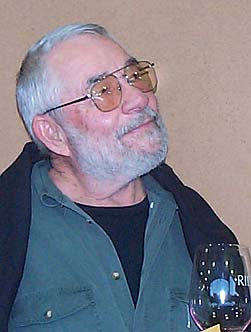 Late last summer I drove north on Hwy 101 through Healdsburg, then Geyserville and Cloverdale to Hopland in Mendocino County. On as picturesque a hillside as you could imagine, I sat down with Richard Sherwin and talked about the Valley Vista Vineyard and Lytton Springs Winery.
Late last summer I drove north on Hwy 101 through Healdsburg, then Geyserville and Cloverdale to Hopland in Mendocino County. On as picturesque a hillside as you could imagine, I sat down with Richard Sherwin and talked about the Valley Vista Vineyard and Lytton Springs Winery.
I first asked him how he learned about the vineyard. It seems he was reading the want ads in the local newspaper…
Richard Sherwin – “60 acre vineyard, $125,000 – $130,000, something like that. I think it was Thanksgiving, and Walt Walters was in the kitchen cooking, and I yelled in to him: ‘Hey, Walt! If I buy a vineyard would you consider taking care of it for me?’
His answer was: ‘Hell, yes.’ That came right back from the kitchen.
So, we called the real estate people, and went over to take a look at the vineyard. There again, the whole romance of the wine and the grapes and the Northern California beauty and everything else.
You know, of course, in those days, you didn’t think so much: ‘Is this a great real estate buy?’ as much as: ‘It’s a piece of land, it’s in the country – that’s what I want.’
So we bought the place, and Walt wound up going to work full time for me, taking care of the vineyard. Neither one of us had any experience whatsoever in vineyard management or farming grapes or anything like that, but he was the kind of guy that was quick to learn, hard working – an absolutely fantastic guy. He just rolled up his sleeves and went around to other farmers and asked questions – so he wound up living up here.
At that time I was flying, so I had a single engine airplane, and I’d come up here as often as I could, which would be a couple of times a month, usually.
Walt lived in a mobile home right there on the Lytton ranch, and it had an extra room that I would use – I would swoop down over the vineyard, and he would know I was there, and I would go on up and do my pattern and land the airplane. By the time I got out of the airplane he was there waiting for me.
He was just a wonderful guy, and we became really good friends – all the way up until 1987 when he had a major heart attack. He was one of these unfortunate guys who genetically aged prematurely. He was in his early 50s – had this major heart attack, and at that point had to back off quite a bit from what he was doing. Six or eight months later he had another heart attack and died.
He was a very important part of my tie to Lytton Springs. I mean when I go by there, when I think of it, I always think of Walt. He was like a brother to me. He was just a fabulous guy. He worked really hard – he got a bunch of his buddies up there, they got a bunch of fork lifts, a steel building – the kind you can just assemble with bolts. They got their fork lifts, and they put this building up.
We were not making big bucks back in those days, so he found ways to make things work. We put up this metal building in 1975 and got bonded – we were making wine every year anyway – we made it in his backyard.
Early on is when I met Paul Draper – just after I bought that vineyard – maybe it was the same year that I bought it, probably 1970. I was up at the old Nervo winery and it was raining outside, and there was one guy in the tasting room and we got a glass of wine to taste, and it turned out to be Paul Draper.
We started chatting and I told him we had just bought this ranch down the street, and he started showing some interest. I guess we had already made our first vintage of wine, which was probably 1971 – the first vintage that Walt and I made was 71 – we didn’t have a winery, we just had the trailer, the mobile home on the ranch. We found this guy down by Lytton Springs who had a barn – he let us use the barn and we had four barrels of Zinfandel that we made.
We drove over there from Nervo, and Paul and I took this wine thief – I didn’t really know good wine from bad – I was doing it because I was having fun. Paul tasted the wine and rolled his eyes a little bit and said: ‘We’d like to buy the fruit from you.’ That’s how our relationship with Paul and Ridge began.
I think the first year we sold to them was 72. Of course, from the get go, Lytton built a fabulous reputation through Ridge. I think in 1976 or 1977 Walt and I were really ready to come out with our own…
Well, there were a few things that helped convince us to do that. One of them was the fact that right about 74 or 75 the price of grapes fell completely out of whack. This old vineyard only produced a ton to a ton and a half an acre, and by this time Ridge had built up a pretty nice reputation with their Lytton Springs Zinfandel. Right at that time the price of grapes went down to $250 a ton – there just wasn’t a market for the grapes. Gallo was setting the prices back in those days, anyway.
So, we called Paul – you know, we only had 30, 40, 50 tons that we would harvest off of that vineyard anyway – I called Paul, and I said: ‘What’s the scoop?’ And Paul said: ‘Well, the price of grapes this year went way down.’ And I said: ‘I know. What does that mean to us?’ And Paul said: ‘We’re going to pay you the going Sonoma County rate.’ Which was $275 a ton or so.
So, that didn’t set too well with me, because I knew the wine was doing well – in those days, they were getting top dollar for the wine, which was $5.25 (laughter). It’s really interesting – the way the values change.
I said: ‘Paul, I don’t think that’s really fair – that’s not enough to even pay the taxes on the place.’ But he kind of stuck to his guns. That’s what got me thinking about what it might take to become a winery.
So we had been making wine in Walt’s backyard and it didn’t seem too complicated. Neither of us had any ‘Davis’ experience, no winemaking experience at all – we would just read these books – very unsophisticated. Thank God the Lytton grapes were just really forgiving anyway, because we did a lot of stupid things, but we still wound up making some pretty good wine.
I sat there one day and I calculated – how many gallons do we get out of a ton? How many bottles out of a gallon, and so forth. I penciled it out – Paul was paying us $275 a ton, but at $5.25 a bottle, we figured we would make many times that – and that got us started thinking about starting our own winery.
I think our first commercial vintage was 76. We actually jumped in the car and drove up to Ridge to talk to Paul. We told him: ‘We’re starting our own winery and wondered if you would give us permission to call it Lytton Springs.’
This may have been a little presumptuous on our part, but Paul also could have said: ‘No.’ But he said: ‘Yeah, I can see why you would want to do that.’ So we named the winery Lytton Springs.
That may have rubbed Paul the wrong way. In fact, I’m pretty sure it did, but we made the trip down from Healdsburg to all the way up to the Ridge winery and we sat down with Paul and we asked him permission to use that name as our wine. At the same time Paul more or less decided that he didn’t want to divide the grapes, or run competition, so it was about that time that we also quit selling grapes to Ridge.”
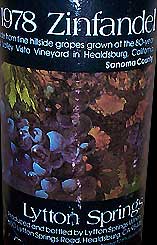 Allan Bree – “There was a period of several years when Ridge did not produce a Lytton Springs wine.”
Allan Bree – “There was a period of several years when Ridge did not produce a Lytton Springs wine.”
RS – “Right. We had this sort of friendly competition going on. One of the things I remember distinctly, and Walt and I would laugh a lot about this – when we came out with our first vintage – 75 – and we said: ‘What should we charge for this?’
We looked at Paul’s Ridge Lytton Springs, and he was charging $5.25, so I said: ‘Let’s do something crazy – let’s charge $5.75.’ Of course, we were an immediate hit; we just really came off, so immediately after we released our wines, Paul’s went up to $6.25. (Much laughter)
We lost touch with Ridge for quite some time, except to say hello at a wine event.
Then Paul decided to approach us about purchasing Lytton – of course, he had always had his eye on Lytton, he knew the quality – I mean the property itself. Interestingly enough, during the negotiation he asked if we would be interested in just leasing the vineyard.
In retrospect, I’m sorry I didn’t take him up on that, because we would have kept the winery part, and he would have had the vineyard – that’s what he was interested in for the most part. He wasn’t really interested in the winery part of it. And most of the vintages had come out under the Ridge label.
But that’s water under the bridge. I’ve not had any regrets about selling it, other than the nostalgia of having a world class vineyard.
The timing was really good for me because at the time we didn’t know anything about making wine, and we were making so many mistakes. We were going to compromise the label at some point – just because we didn’t have the Davis-type training and Walt passed away, and this young kid came to work for us at that time and he became the winemaker by default.
All we did in those days was add yeast and let it ferment. We never sent out for lab reports. We had a serious VA problem and didn’t realize it for four or five years. We kept sending wine over to Napa to get reverse osmosis – eventually I figured out that we were not taking good enough care of the wine. We were letting the barrels evaporate, we weren’t keeping our SO² levels up.”
AB- “That was real ‘seat of the pants’ winemaking.”
RS – “That was all ‘seat of the pants’ winemaking.
And by this time, I was kind of burnt out. And Paul comes along, and we’re talking big bucks. It helps to have a guy like Otsuka behind you. (In 1986 Ridge Vineyards was sold to Akihito Otsuka, owner of Japan’s Otsuka Pharmaceutical Company.)
Actually, before I sold Lytton, I bought this place. Actually, before Paul even approached me about buying Lytton, I had bought this place. I just knew it was really good real estate, and it was.
When Paul approached me, and we had already made one or two vintages from this vineyard (Mendocino Hill) – we had made some Cab – and the Cab was really showing well. So I thought: ‘I can have my cake and eat it, too. I can sell this place (Lytton Springs), and I already own this place (Mendocino Hill) so I have a place to go. I can start a little winery up here and this time be well financed to do it.’
So – it was a pretty good offer, and we decided to sell and move up north (to Hopland). That turned out to be a pretty good decision on our part.
The bad decision was starting another winery. ” (laughter)
AB – “Could you tell us what you know about the history of the property?”
RS – “Well, not a lot. I know there was a sea captain with the name of Lytton – that popped up somewhere.
I tried to do a little research on the ranch. I bought it from a family with the name of Frost – it was called the Frost Estate. The owner had a number of kids, but none of them wanted to farm it. So when he died, it came up for sale – back in 69 or 70 when we bought it.
This fellow Frost had owned it, and the best we could tell, the ranch had been there since the 1870s – so it was easy for us to say that this was a hundred-year-old vineyard. It was one of the few head-pruned vineyards left in Sonoma County.
When a farmer starts seeing production drop like that, he’s going to rip out those vines, and plant young vines to get the production up. But because of the quality, we knew we had a special vineyard all along. That was a nice thing, and it worked to our advantage.
I didn’t really spend a lot of time trying to find out what was going (history) on with that vineyard way back – it was on my list of things to do. One of the things that we collected was about a half dozen of these little bottles – over next door – the Lytton…where the Salvation Army is right now – there was a spring fed water plant where they bottled mineral water.
I can’t tell you much about the history, because I don’t know. We didn’t really have the time it takes to go through the archives and such. I’m hoping that between you and John (Olney), you’ll come up with more information.”
AB – “How many acres were under cultivation?”
RS – “Sixty. We sold ten of them – we sold the little piece across the street from Lytton. We found that was a really difficult piece of property to farm and we were getting very few grapes off it. We weren’t getting the fruit ripe so we sold that off.”
AB- “Who was the unlucky recipient of that fruit?”
RS – “Terry Sweet. He was a real estate broker – he eventually sold it. It’s been through a number of hands. It’s probably worth more than I got for the whole ranch by now.” (laughter)
AB – “Was the ranch predominantly Zinfandel?”
RS – “It was mixed. It was predominantly Zinfandel, but back in those days, those old farmers put whatever they could find in there. There was some Carignane and Petite Sirah – I think there were even a few Mission vines in there. Back in those days, the BATF didn’t get on your case if you had a mixed bag, and we just threw it all in the crusher.”
AB – “How did you come to make a reserve wine with the Lytton Springs Winery label?”
RS – “It was a marketing strategy. I think we found that if you put the name ‘Reserve’ on it you could get more money for it. It was that simple. It was just as good a wine as our regular wine – maybe we left it in barrel longer, but it was just part of the mystique, and we took advantage of it. If you put ‘Reserve’ on the label, you could get five or ten bucks more for it.”
AB – “Did it always come from a specific block on the estate?”
RS – “No. It varied quite a bit. We didn’t do anything very sophisticated at all. We would just make the wine and later on we would go back and taste it. We’d say: ‘Okay, let’s make this the reserve wine and this the regular.’ Or: ‘Let’s do 500 cases of reserve and 4000 cases of the regular wine.’
It was all kind of tongue-in-cheek. There was nothing very scientific about it.”
AB – “It sounds almost comical in contrast to today’s sophisticated laboratory analysis, multiple blind tastings – but you achieved some notoriety and success to some degree.”
RS – “It all goes back to what Paul Draper was looking at. The fact is that this old vineyard was so special. The grapes – as you know – consistently produce such extremely high quality wine. It was just being in the right place at the right time.
It’s just a great vineyard, and Paul recognized that. That’s what he was looking at when he made us the offer to buy the place. He made a good decision because he lives to make great wine. I don’t think my ego gets in the way when it comes to winemaking, because those years were wonderful years for us and we wound up making damned good money on the property. So I have such pleasant, pleasant memories about the whole thing.
The fact is that there is something about those old head-pruned vines. It was not irrigated. The fruit just got good and ripe and we never had any trouble getting good sugars and good healthy berries. No matter what we did wrong, it was very forgiving. It was just beginner’s luck. I’m very unsophisticated when it comes to wine, and I have always been. I’ve never taken the time to learn the scientific part of it – I’ve just had too many other things in my life.”
AB – “Could you tell me a little about what it is like to work with Paul Draper?”
RS – “Paul is so dedicated and so intense. He was totally different from the way Walt and I worked. We didn’t care – we liked to see the awards we were getting, we liked to see our name in print and if we didn’t win something, it didn’t bother us.
Paul takes the wine business very seriously, and in my opinion he takes it much too seriously. So, there’s no room for errors with Paul, and I think that’s where Paul and I ran into some problems after the sale of the winery.
We did hang out there for a while after the sale on a consulting level, but I eventually learned to back off a bit because Paul was calling the shots.
But I hand it to Paul – he’s one of the most prestigious winemakers in California, he’s a pioneer, he’s absolutely intense on making the best wines in the world. But that is where our personalities differ a lot. I can’t take things that seriously, because I need to have some fun in my life, and I can’t take myself that seriously.
I have a lot of respect for him as a winemaker – he’s an absolutely fabulous winemaker – his life is making wine. He’s gotten into scientific methods of making wine, and you can’t fault him. He’s made a great name for himself.”
AB – “It seems that you look back at those days with no small amount of affection.”
RS – “Those were good years, and Walt was a big part of that. We had a lot of fun and he had a great sense of humor. When we started making wine, we went down to Bellagio’s cooperage in Windsor, and we bought – back in those days redwood was one of the choices for winemaking tanks. We had them make us a little five hundred-gallon fermenting tank, and I think a six or seven hundred gallon holding tank. But everything else was – go down to the hardware store and buy a little pump, and a strainer, and we had a basket press back then. We spent all day making wine, working hard, and we would make a barrel or two and it would wind up in Walt’s garage, which was awfully warm so we wound up losing wine more often than not, but it was so much fun. And he was such a neat guy to have in my life because we just enjoyed the hell out of ourselves.”
We sipped on a couple of Ridge offerings from the early 90s, and talked through a wide range of topics as the afternoon wore on.
I took an immediate liking to Richard Sherwin. He is both a gentleman and a gentle man.
I wanted to get to know him better, so I extended an invitation to him and his wife to join us for dinner in a couple of weeks.
Happily, he accepted.
Paul Draper on Lytton Springs
The following is the text of an interview of Paul Draper by Charles Sullivan. It is excerpted from A Companion to California Wine: An Encyclopedia of Wine and Winemaking from the Mission Period to the Present, which was compiled and edited by Mr. Sullivan and published by the David R. Bennion Trust. It is used with the permission of the author.
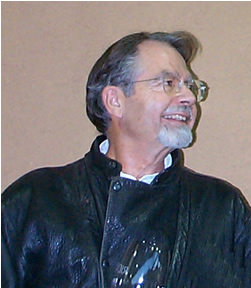 Paul Draper – “I think Richard Sherwin lived for years on a street called Valley Vista in Southern California. He came up here and purchased his vineyard in 1971. He sold grapes to Mondavi in that year and made a tiny amount of wine for himself. (He might have bought it in 1970) He called it Valley Vista Vineyard, and he continued to call it that right up to 1991.
Paul Draper – “I think Richard Sherwin lived for years on a street called Valley Vista in Southern California. He came up here and purchased his vineyard in 1971. He sold grapes to Mondavi in that year and made a tiny amount of wine for himself. (He might have bought it in 1970) He called it Valley Vista Vineyard, and he continued to call it that right up to 1991.
We met by chance one rainy day in the tasting room at the old Nervo Winery in Geyserville in the winter of 1971-72. I was standing there and Frank Nervo was serving us some of his old wine and we got to talking. So he told me that his grapes were just going into the Mondavi Zinfandel blend and he was interested in our single vineyard approach. He asked me to come over to the vineyard and we came to terms for the 1972 vintage.
As we approached time to bottle the 1972 I had to start thinking about what to call the wine. Dick wanted to call it Valley Vista, but I had already decided that I didn’t think that was a suitable name for a wine of this quality. I had been looking at topographical maps and had seen a series of springs there and the old hotel. And there was an old stop on the Southern Pacific tracks called Lytton Station. At least one of those springs was on his property and it was the name given to the road. That was enough for me, and I told him I was going to call it Lytton Springs. Dick said that would never work commercially. He suggested I call it Healdsburg or something like that. But I went with Lytton Springs.
The 1972 was quite Burgundian-like. It had an extended fermentation that gave it a certain spiciness and earthiness, which was unusual for a Zinfandel. It was rather exotic. The 1973 was one of the most perfectly balanced wines we ever made. It was really in a rich claret style. One of the things that gave the Lytton Springs wine such a good balance was that it had about 15% Petite Sirah mixed in the vineyard. These were vines that had been planted around the turn of the century. They were on St.George rootstock.”
Charles Sullivan: “So, they were definitely planted after 1897, but probably before 1905.”
PD – “We also found there was a little bit of Grenache in there and also a small amount of Carignane. They added further complexity to the wine and it showed me that some of those old growers knew how to put together a well-structured Zinfandel right in the vineyard.”
CS – “And the Petite Sirah also added color that was much liked back then.”
PD – “The 1973 Zinfandels were not as rich and deep in color as the 1970s had been. (I used that vintage as a sort of standard.) So I decided that in 1974 we were going to get more extraction. With that we increased the number of pumpovers with a submerged cap fermentation. Plus that, we had a beautiful year, a little warmer than in 1973. So we got more tannic wines in 1974; the Lytton Springs initially was quite tough and not as immediately pleasing as the 1973. But it has aged beautifully. The 1973 and 1974 Geyserville were also great wines. We included a small amount of the Lytton Springs Petite Sirah in the 1973 and it gave the Geyserville more structural complexity that it would have had if it were 100% Zinfandel. Those two vintages really taught me a lot about vineyard blends for Zinfandel. I tasted these Geyserville wines with Philippe Dourthe in the late seventies. Both were lovely wines but there was no question that there was an added level of complexity and depth in the 1973.”
CS – ” Even though 1974 was overall a better year in Sonoma for making that kind of claret.”
PD – “Yes, and I think it was because of that addition of the Petite Sirah. That was a turning point. So I decided that we should take some of the Petite Sirah that the Trentadues were already growing. We would start including some of those grapes from the older blocks in the Geyserville Zinfandel.
We made the Lytton Springs wine through 1976. In 1975 we had a somewhat heavier crop and it was a fairly cool year in California. We handled the grapes as we had in the previous years, but when the wine was released people said we had changed the style. It seemed softer and lighter and more readily drinkable, but it had absolutely nothing to do with our approach in the cellar; it was the nature of the vintage.
After the 1976 vintage Dick Sherwin came to see me. He had been making a small amount of wine every year from his grapes. He now wanted to bond the winery, but he realized that he was going to need all the grapes if he was going to make the thing work. We had a handshake agreement for five more years, and he was willing to honor it, but then he’d have to go outside and buy grapes to make up for what we would be taking. I told him that we had had to leave the grapes from the flat part of the vineyard out of the Lytton Springs wine and put it into our Coast Range Zinfandel because it didn’t have the intensity of the hillside grapes there. I knew that if we shared that vineyard we were going to be arguing every year about who gets the flats and who gets the hills. I told him that I’d rather step away than go through that.”
CS – “You didn’t get Lytton Springs grapes after that?”
PD – ” Well, that part of the story is coming. We had wanted to expand production. And right to the west of Dick’s place, virtually contiguous to it, was the old Norton Ranch. I had looked at that ranch but it was far too big for Ridge to buy. Sherwin asked if he could call his winery Lytton Springs. Our wines since 1972 had really gotten good press, particularly in the ear (?), under our Lytton Springs label. They had won all kinds of awards. He said that if we’d let him use that name he’d be able to sell every bottle. I said OK, since we had no place to get the grapes to go with the name. Then in 1984, one of the major shareholders here at Ridge, Bill Hambrecht of the Hambrecht & Quist investment banking company, bought the Norton Ranch because of his interest in Zinfandel. He first had the idea of making wine himself. And he did make some in 1984. But he decided not to go ahead with the idea of a winery, so he offered us the grapes and some of the 1984 wine he had made. We took him up on it. From then on we produced a Lytton Springs Zinfandel just from the Norton Ranch. I checked first with Dick Sherwin, and he said it was our name anyway. But this time we wrote up a legal paper agreeing on the use of the name. I had to pay him a significant amount to make it a contract.”
CS – “Right, there has to be legal consideration.”
PD – “His idea was that we have dinner together in Santa Monica at Michael’s Restaurant. Our old friend Phil Reich from the Liquor Barn in Colorado was in charge of the wine there. He had made Zinfandel famous throughout the mountain states.”
CS – “I met him at David Bruce’s one time. He was a true believer.”
PD – “Maureen and I went down and we brought all our favorite vintages. Phil joined us for dinner. Endless bottles of old Lytton Springs vintages. The meal cost about $500, and that was the consideration for the contract.
We went on making Zinfandel from the Norton Ranch and then began to hear rumors that Lytton Springs was sort of quietly for sale. At that point I talked to Dick and he was open to discussing it. Here at Ridge we could see that another wine company might step in, buy the vineyard and start using the name.”
CS – “Right. Now that you have a contract with Sherwin he could sell his interest, including the name, to someone else, unless your contract precluded it.”
PD – “So I got very serious. We got John Fisher and Jean Michel Valette of Hambrecht and Quist to work with us. So we were able to give Dick exactly what he wanted. His real interest was in his Mendocino Cabernet vineyard. It had been difficult for him to break even with the Lytton Springs Winery, let alone make a profit. We started this in early 1991 and by September we closed the deal. So now we owned the original vineyard he called Valley Vista, and on the same property the little winery. Now we had full rights to the Lytton Springs name.”
CS – “You have the old BW there, the number.”
PD – “Yes. We bought it just prior to harvest in 1991. That was the first vintage in which we brought all the Lytton Springs vineyard grapes down here, along with the grapes from the Norton Ranch, and from the Maple vineyard to the west. There are three virtually contiguous vineyards in a line running out Lytton Springs Road.”
John Olney
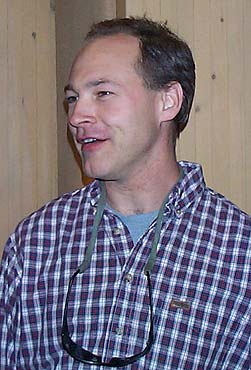 John Olney joined Ridge Vineyards in 1996, and is now winemaker at Ridge Lytton Springs. He joins a small and very talented group who have served and learned from Paul Draper: Steve Kistler, David Noyes (Kunde), Gordon Binz (Renwood, Villa Toscano) and Mike Dashe (Dashe Cellars).
John Olney joined Ridge Vineyards in 1996, and is now winemaker at Ridge Lytton Springs. He joins a small and very talented group who have served and learned from Paul Draper: Steve Kistler, David Noyes (Kunde), Gordon Binz (Renwood, Villa Toscano) and Mike Dashe (Dashe Cellars).
We sat down to talk in the house that sits on a knoll near the winery, surrounded by ancient head-pruned vines. Construction on the new winery was buzzing along with a sense of urgency, since crush was soon approaching.
We started by chatting about John’s late uncle, Richard Olney – a renowned author of a number of wine and food books.
Allan Bree – “John, some folks may not know that you are the nephew of Richard Olney, who happens to be one of my favorite wine and food writers. Could you speak just a little bit about Richard and your relationship with him?”
John Olney – “Sure. Richard is the one who got me into all of this in the first place.
I was running around in Europe after completing a language program in Germany, and I went down to visit him at his place in the South of France.
I was pretty innocent at the time – I was only about twenty – and things like Yquem, La Tache, Tempier, Vieux Telegraphe and Chave just showed up at the dinner table every night. Remember, this was still pre-trophy wine era. Besides anyone who knew Richard understood he wasn’t much for posturing. These were just wines he admired made by people whose work he respected. Anyhow, I didn’t know what I was doing, but it didn’t take long to get drawn in.
Richard just had amazing connections – he got to know people who are huge figures in the winemaking world today when some of them were kids, some of them were just starting out, some of them were struggling to sell their wine. So, he developed a lot of friendships that way and obviously that opened all sorts of doors. The next thing you know, we did a tour through all of Bordeaux, we did a tour through the whole Rhône, we did a tour to Burgundy, went down into the cellars and tasted back into the 50s, and then after lunch, went back even further with the cheese course.
In a nutshell, I would say that was how Richard got me started.”
AB – “There is a circular connection between the Olney family, Domaine Tempier and Ridge. Could you explain that a bit?”
JO – “I think people who share a similar view of the world, or philosophy or whatever you will – I think there is a little more than chance that brings those folks together. People who agree about “stuff” hang out together.
Obviously, in terms of Tempier, the fact that my uncle was already there brought a lot of my family on site. The South of France is still a pretty good place to spend a vacation. When you meet people, I think it doesn’t take too long to figure out if there’s a common thread.”
AB – “Did that facilitate your entrée to Ridge Vineyards?”
JO – “I think it did – sort of in the same sense. Paul has a similar philosophy to, for example, Domaine Tempier, certainly in terms of winemaking, and it just seemed natural to me to check out Ridge. When you go back and look at what Paul was doing back in the 70s – and even today – he was doing things that were quite different for California at the time, and I think I share that “natural approach”, that “forget the recipe approach” – whatever you want to call it – to winemaking.
But there was also the connection that before I went to Ridge I went to work for Kermit Lynch. Paul had stayed in touch with a lot of European wines through Kermit, so he would come in from time to time, and then Paul was also a friend of my uncle’s.”
AB – “So, how long have you been here now?”
JO – “Well, I guess I’ve been here…I was at Firestone when I first got back from France – that was 1995 – a good friend was the general manager there, and placed me in the cellar crew. I learned how to drive a forklift really well (laughter) – so it was 1996 when the opportunity at Ridge became available.
AB- “You began in Cupertino?”
JO – “Yes.
AB – “In what capacity?”
JO – “Basically, I went right into the cellar with the cellar crew, and started working with them. It was great for my Spanish. Then, I was participating in all the tastings and gradually gained more responsibility from there.
AB – “Let’s talk a little bit about the Lytton Springs facility. Up until this new construction phase, which wines were produced at this location?”
JO – “In 1991, Ridge purchased the Lytton Springs property and the winery that came with it. The winery was called Lytton Springs Winery. It was a completely separate entity from Ridge. However, in 1972, Paul was the first person to purchase the grapes of Lytton Springs Vineyard from Richard Sherwin, the person who owned Lytton Springs Winery. A few years later, Lytton Springs Winery put out its own Lytton Springs label that had a black label with a psychedelic looking cluster of grapes on it. So then, after 1991, Ridge chose to keep on using this same Lytton Springs Winery (black) label, and to continue to produce a rustic, all around rich Zinfandel from a number of different vineyards around Sonoma County.”
AB – “So, those last three or four vintages of Lytton Springs Winery Zinfandel were actually produced by Ridge?”
JO – “Correct. I’m not 100% sure, but I’ll say 92, 93 and 94. In 95 we decided to come out with our own label – it seemed natural – and that’s when we launched the Sonoma Station. Many of the vineyards that went into the Lytton Springs Sonoma County wine were retained, others were added, and it changes a little bit every year.”
AB – “In terms of sources?”
JO – “Correct. We also make some of the ATPs (Advanced Tasting Program wines), We got access to a terrific old vines vineyard owned by Stan Buchignani, and started making his Zinfandel and Carignane here.
Frequently, since we are so into Zinfandel and since sugars with Zinfandel can easily get out of hand if you don’t pick when it’s ready – we pick so many grapes in a day that grapes destined for here (Ridge at Lytton Springs) would go to the other winery (Ridge at Monte Bello), and more often, grapes destined for the Monte Bello winery would come up here, so there is a juggling that has been going on.
With the new facility having a lot more capacity and better equipment, I think we are able to plan our lives a little more rationally.”
AB – “I remember hearing a story that one of the wines – I can’t remember specifically which wine it was – needed to be designated “late picked”, because at the time you were ready to pick there was simply no tank space, and the fruit had to be left hanging for two or three days, until there was room for you to crush.”
JO – “The “late picked” designation was Paul’s idea, and I think a very good one. The idea was to try to let people know that this was a wine that was not a “late harvest”, but it’s going to be heavier and have more alcohol than a typical table wine, claret style, something in the 13-14% range.”
AB- “The equivalent of a warning label.” (laughter)
JO – “You could say that (more laughter), although I don’t think many people take heed of that warning label if you look at the kind of Zinfandel that’s been made for the last seven or eight years.”
AB – “I agree with you, but that may be a whole separate discussion.
Well, with the new facility now, how is that going to change the distribution of where wines are produced?”
JO – “The old facility was quite modest. First, we didn’t really have the capacity, nor did we have the equipment – the variety of tanks that we wanted to have or fermenters – to be making one of our top wines, such as the Lytton Springs.
So, now that we have that, the biggest change will be to actually bring all of Lytton Springs grapes here to this winery, whereas previously it was made all at Ridge (Monte Bello).
AB – “Do you think that will – it would seem to me as a layperson, that having the grapes brought directly from the vine to the hopper can only enhance the quality of the wine.”
JO – “I think the vintages of Lytton Springs that were made, even with the hauling all the way up to Cupertino – judging on the quality of the wines – didn’t suffer too much.
But certainly the control over what and when to pick is greatly increased. So rather than needing to say, fill up a truck, or picking only so much because that’s all that fits on a truck, here you have the option of proximity, where you can do a little back and forth. You can pick that block right now, and after lunch we’ll go over and pick that one – that sort of thing.”
AB – “So, do you think there will be more and smaller lots processed individually?”
JO – “To me, the greatest advantage to having the winery right next to the vines is that you increase the opportunities to catch the grapes at that ideal moment that we all talk about, (and never really know if we have). Whether that means we will be picking in smaller amounts, or perhaps larger amounts, because we see that everything is ripe and we can do two truckloads in one day – because we have to – remains to be seen.
97 is a good example. Had we been able to pick everything at once, we probably would have killed ourselves, but maybe we would have made an even better wine.”
AB – “I’m glad you mentioned 97. Just last week I happened to open and serve a 97 Grenache and a 97 Syrah (both ATP wines) at a friend’s home to accompany dinner and they were both very, very impressive.
Could you tell us about the Rhône variety program – how it got started and where it’s heading? I know it’s something that Paul is very excited about.”
JO – “Oh, absolutely. I guess there’s two parts to that. First Grenache, which, oddly enough, you don’t see that much, especially in this area – Dry Creek. One of the hills here at Lytton is planted to Grenache – very, very old Grenache. You especially don’t see that often – they might have had a French intern here that year during planting, and he got away with it.
Paul began fermenting the Grenache separately in the early 90s. In 95 we blended roughly 50% Grenache and Zinfandel. Then, in ’96 we released the first varietal Grenache as an ATP. We then planted some more Grenache next door at the Lytton West (Norton Ranch) vineyard. It took off from there.
I think the inclusion of some Zinfandel and Petite Sirah – which is growing side by side right there on that hillside – to me, makes a better wine. So, I’m certainly excited about it.
And the Syrah was the kind of thing we just fell upon – it had been planted by the Hambrechts when they owned the Norton Ranch. So, when Ridge purchased that ranch in 95, in 1996 they harvested the Syrah, and when it came in the idea was: ‘let’s see what we get.’
It really surprised all of us, and I think that’s where the excitement came from. We still are making the wine down at Monte Bello – Paul and Eric have been getting to know the grapes better, and I think the wine keeps on improving.”
AB – “I heard through the grapevine, if you will, that there was a rather highly regarded French winemaker who exclaimed after tasting the 98 Syrah: ‘This is what the grape should taste like!’
Do you know if there is truth to that tale?”
JO – “I can’t confirm or deny it. (laughter) I think I would actually agree with it – there’s a purity of flavor there, whether you want to say that it’s more French or more Californian…”
AB – “That’s an argument I will not take part in.”
JO – “Right. I tend to not go down that road – it doesn’t seem to mean much.”
AB – “Do you think the – it’s hard to call it ‘experimentation” – the venture into Rhône varieties will continue here?”
JO – “I think it will continue, but we’re after something that is of the highest quality. Growing the grapes in the right place, and producing something of quality is essential to us. For us to go out and buy a bunch of Syrah from any vineyard that has it just to keep the program going or to “build the brand” is just not what we’re about.
So, yes – I think it will keep going, but we’re not in a hurry.”
AB – “What’s in the future for you and Ridge Vineyards?”
JO – “Well, hopefully, variations on the themes of the past – continuing to make outstanding Zinfandel and outstanding Cabernet, and all the other things we do. I think that it’s important that we remain focused.
I have no problem – once I’ve found something I like doing – just sticking to it. My wife calls me the ‘young curmudgeon’, so I think it’s just holding on to what got you there in the first place, which is the quality of the wine.”
AB – “Have you found a home here – I mean in a figurative sense – regarding winemaking?”
JO – “Oh yeah, definitely – I’ve found a home in all senses here. I love it here.”
AB – “It must be extraordinary to work with Mr. Draper on a regular basis.”
JO – “It is. It’s great experience and it’s obviously enormously educational.”
Degustation
A Vertical Tasting of Five Vintages Of Ridge Lytton Estate Zinfandel
A couple of years ago two intrepid ZAPpers and I collaborated to create a lot for the ZAP festival auction. It included a complete vertical of the five vintages of Lytton Estate Zinfandel that Ridge produced in the years immediately following their purchase of the vineyards and winery. These wines were blended from selected lots and blocks on the property, perhaps representing the best of what the estate had to offer.
The nice folks who purchased the lot at the auction did not redeem it, so I was left with these five bottles of Zinfandel that were looking for a time and place to be tasted.
Who better to share these wines with than Richard and Dorinda Sherwin, who had provided such devoted stewardship of these vines?
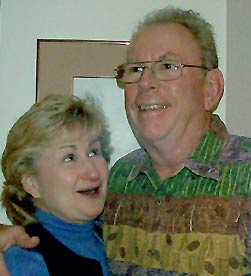
Joyce and Frank Ortega
We gathered at the beautiful home of Joyce & Frank Ortega, who live a mere mile or two from Lytton Springs. Joining us were Richard & Ona Flores and Dave & Jeanine Layland.
We started with a couple of chilled whites, then sat down for a structured tasting of the vertical. The bottles were freshly opened.
The Lytton Estate was offered as an ATP release for five vintages: 1991, 92, 93, 94 and 96. I have heard that the 1995 Lytton Estate was inadvertently blended into the Lytton Springs national release, and was therefore lost as an ATP wine. Further, the decision-makers found that the addition of this wine added so much to the character of the Lytton Springs that production of the Lytton Estate was discontinued after the 1996 vintage.
The only time I score wines is when I’m asked to at panel tastings, so tonight I asked our group of tasters to rank the five wines in order of preference and to add some brief comments. I’ve given three points for a first place vote, two points for second and one for third. Here’s what we thought:
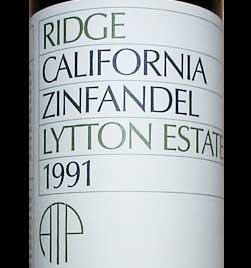 1991 Lytton Estate 86% Zinfandel 7% Petite Sirah 7% Grenache 15.4% alcohol 23 barrels produced “perfumey…spice” “ripe…cherry…jam” “youthful aromas; pepper, earth; good structure; long finish” “wonderful nose – classic” “strawberry jammy nose” “black cherry flavors…long finish” “great old Zin fruit flavors” and my notes: deep plummy aromas – ripe & pretty – well balanced – a touch hot.
1991 Lytton Estate 86% Zinfandel 7% Petite Sirah 7% Grenache 15.4% alcohol 23 barrels produced “perfumey…spice” “ripe…cherry…jam” “youthful aromas; pepper, earth; good structure; long finish” “wonderful nose – classic” “strawberry jammy nose” “black cherry flavors…long finish” “great old Zin fruit flavors” and my notes: deep plummy aromas – ripe & pretty – well balanced – a touch hot.
Find Ridge Lytton Estate wines
This was by far the favorite wine, garnering six first place votes and a total of 21 points.
1992 Lytton Estate 88% Zinfandel 7% Petite Sirah 5% Alicante 14.4% alcohol 23 barrels produced “old fruit flavors” “slight barnyard character to nose – smooth, melded fruit flavors” “strawberry nose with some vanilla – lots of tannins – needs time” “touch of brett in nose – still a good wine” “earth aromas – berries, good acid, tannins, high alcohol – medium finish” “tobacco” “leathery nose” and mine: black cherry & red plum nose – very well integrated flavors.
Second place overall with one first place vote and 9 points.
1993 Lytton Estate 88% Zinfandel 12% Petite Sirah 15.1% alcohol 52 barrels produced
“almost gamy” “slightly sour with watery, flat finish” “old leather taste – vegetal” “heavily oxidized – …bitter that offset flavors – lots of black pepper – finish is better than flavor of wine on tongue” “leather/tobacco” and mine: “dense, dark, muddled aromas – well blended flavors – lovely spice.
Placed last with 4 points – no first place votes.
1994 Lytton Estate 70% Zinfandel 17% Petite Sirah 13% Grenache 13.4% alcohol 53 barrels produced “nose woody (not oak) – tannic feel remains on tongue” “slightly corky nose – slightly tart, short finish” “possibly a little corked – a little musty” “classic” “youthful aromas – excellent fruit smells: berry, plum – lacks deep throated flavors of ripe fruit – disappointment” “unripe” and mine: Corked! – low-level – fruit DOA – touch of funk, but lovely spice.
Placed fourth overall with 5 points – no first place votes.
1996 Lytton Estate 60% Zinfandel 35% Petite Sirah 5% Carignane 14.6% alcohol 47 barrels produced “no fruit in nose – compost smell – vegetable in mouth” “dusty nose – balanced fruit flavors” “old vegetable nose – wet vegetation – strawberry – sweet” “luscious aromas – smoky oak, good blackberry – lingering finish with good spice – very young – needs time” “unusual nose (that) blew off” and mine: sweet vanillin in the nose – very harmonious – still tight – needs time.
Placed third overall with 8 points and one first place vote.
The wines were tasted first without food, and then some of Joyce’s lovely appetizers were served to accompany the wines, giving us another perspective.
Dinner consisted of a boned and butterflied leg of lamb, anointed with a dry rub and grilled. This was accompanied by a potato gratin and seasonal vegetables. More wines were uncorked, including several Lytton Springs Winery bottlings that Richard and Dorinda were gracious enough to bring along.
The evening wound down with a couple of late harvest wines, including a 1977 Monterey Peninsula Winery Late Harvest Zinfandel from the Willow Creek Vineyard – a splendid elder statesman for the potential of these sweet wines to age gracefully.
It was indeed a wonderful evening, filled with good food, comradeship and featuring the wonderful wines from the Lytton Springs estate. What made this especially memorable was the opportunity to get to know the Sherwins on a more personal level. These are wonderful people, and I’m glad they own this little piece of California Zinfandel history.
We need more folks like this in the industry.
Construction
The new winery at Lytton Springs
Some of you may remember the Lytton Springs Winery.
It was, to say the least, rustic.
And while the winery suited the intended purpose in it’s heyday, it clearly did not meet the winemaking style and requirements of the new owners. When the logistics and expense of trucking all their fruit to Cupertino (and up Monte Bello Road) was considered, it seemed fairly obvious (to me, at least) that some type of improvement to the Lytton Springs facility was inevitable.
Uh…did I say improvement? ‘Scuse me.
What Ridge proposed was to build a new winery around and enclosing the old, then demolish the old building. Extraordinary.
The construction goal was to create “an environmentally friendly building that uses recycled materials and keeps energy consumption low.”
The construction method chosen by the architects – Freebairn-Smith & Crane of San Francisco – was straw bale. The bales are made from rice straw, which contains no nutritional value and is therefore vermin resistant. Because the tightly compacted bales contain so little oxygen, the bales are also fire resistant. In fact, the outer walls provide a two-hour “firewall”. The rice straw is sourced from the San Joaquin Valley – each bale measures 23″ by 16″ by 42 – 48″, and weighs 80 – 100 pounds. The walls are covered with wire mesh, then a plaster composed in part from local soil with clay, several different kinds of sand, straw, natural pigments (burnt umber, ferrous oxide and ferrous sulfate) and 2% linseed oil was applied with trowels. The walls were sponged, then covered with a lime wash in areas where moisture was of concern.
The resultant structure has an insulation value of R60 – similar to that of caves. Warm weather cooling is provided by a system of thermostatically controlled louvered vents located at the base of the exterior walls and in the roof’s cupola. Cool evening air enters at the base, forcing warm air out through the upper vents, thus cooling the building by convection.
The roof contains a total of 384 photovoltaic solar panels, capable of generating 64 kilowatts of power directly from the sun. While the goal is net zero electricity consumption, the building may, in fact, be able to sell power back to the grid.
Additional construction materials included recycled oak, decay-resistant Alaskan yellow cedar and Pennsylvania flagstone. The tasting room bar is faced with Zinfandel stained tank staves from the original winery.
With a footprint of some 18,000 square feet, the new winery is the largest straw bale construction project in the United States, and possibly in the world. When outfitted with its complete array of production equipment, including a bottling line, this facility will give Ridge additional flexibility to elevate their already world class wines to even higher levels.
Celebration
An evening devoted to the wines of Lytton Springs
There could be no tasting more anticipated, no gathering more appropriate, no evening more poignant than that of the first day of November, 2003.
Spearheaded by Terry Rooney and Rich Hoffman, a group of intrepid Zinfandel lovers created and conducted a “Salute to Lytton Springs” at the new Ridge tasting room built on the site of the original Lytton Springs Winery.
For those of you who may not realize, it is not easy to lure Paul Draper from his idyllic home and winery on Monte Bello Ridge, but he ventured north that evening to join us, and arrived in fine spirits. Richard and Dorinda Sherwin trekked south from Hopland to participate. John Olney had the shortest journey – down the stairs from his office.
They and some seventy or so other Lytton Springs aficionados joined together to celebrate this very special piece of ground and the extraordinary wines it has produced.
The generosity of the wine community amazes me, and this event was no different. Every attendant either purchased or brought a wine from their collection to include in the tasting. Indeed, after putting out a message on the Internet wine bulletin boards, folks I had never met offered older bottlings to include in the festivities. Having been drafted as “wine steward” for the evening, it was my pleasure to decant and sample 31 bottles from 1989 and earlier. I was amazed and delighted to find that none were cork-tainted, and while some were certainly more interesting that others, not one bottle was over the hill. Vintages back to 1978 were represented, including a rare “custom crush” Zinfandel, and a 1987 Mendocino Cabernet Sauvignon – sourced from the vineyard Richard bought outside of Hopland and produced at Lytton Springs. Added to those were the “modern day” Zinfandels produced by Ridge, up to and including the current release. It was a Lytton lover’s fantasy tasting.
The evening began on the crush pad with a taste of the 2001 Ridge Lytton Springs, provided by the Lytton Springs hospitality staff. Here’s my note from March of 2003 – if anything, the wine has gotten better:
2001 Lytton Springs – 76% Zinfandel, 17% Petite Sirah, 7% Carignane, 14.7% alcohol – Fairly reticent aromatics, but with some swirlitude, gives up the signature aromatic profile of this wine, which features compote of blueberry, blackberry and purple & black plum. In the mouth there is no doubt that this is Lytton Springs – the flavor profile is familiar, there is good balance and structure for aging. It is certainly far from showing it’s best, but I think it is the Lytton Springs of the Century (so far). find this wine
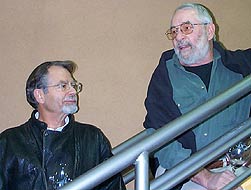
Paul Draper and Richard Sherwin
Mr. Draper then treated us to a narrative of his “discovery” of Lytton Springs and its relationship with Ridge Vineyards. Mr. Sherwin then regaled us with more tales, and his earlier recollections. Mr. Olney provided brief tours of the new winery. It was Lytton Immersion.
We then adjourned to the new tasting room, where the seeming endless array of Lytton wines were lined up on the tasting room bar – a bar faced with staves from the tanks that Richard Sherwin had contracted, stained with some of the very wines we were tasting. Attendees brought nibbleybits as well – all matched well with the wines.
I simply couldn’t bring myself to take notes.
The evening went by far too quickly, and we needed to allow the hospitality staff to get home at a decent hour, so we closed the event in time for folks to get to dinner.
As George Heritier would say: “I have a reputation to live down to”, so I’ll try not to get too maudlin here, but this was one extraordinary evening. To taste this fabulous retrospective of wines from a single source; to see Richard Sherwin and Paul Draper renew their friendship after so many years; to witness the rededication and commitment to this unique piece of ground – these are wine memories that I will always carry with me.
I am very thankful to have been there.
More Thanks…
To Richard and Dorinda Sherwin – for their friendship, their generosity, and more than anything, for Richard’s devoted stewardship of these fine old vines.
To Paul Draper – for his dedication to single vineyard Zinfandel and for contributing his presence to our evening event.
To John Olney – for his interest and participation in the preparation of this story.
To the Healdsburg Historical Society and Holly Hoods, their research curator, for her assistance with my search.
To Frank and Joyce Ortega – for being such gracious hosts for our retrospective dinner.
To Terry Rooney and Rich Hoffman – for organizing and executing the “Salute” event.
To Matthew Cooper, Bruce Leiserowitz and Mark Meyer for sending older Lytton Springs bottlings to me for a tasting they would not be attending. I am constantly amazed at the generosity of this community.
To Michael Perry, Christina Donley and the rest of the Lytton Springs hospitality staff – for helping us create a flawless evening with a lifetime of memories.
A Final Word
How fortunate to have this vineyard owned and tended by folks who understand its worth.
How fortuitous to be present at this unique convergence of winemakers and their efforts.
How remarkable it is to be able to look forward to more wonders from this extraordinary piece of land.
For all this, and even more that I’ve not told you about, I am more grateful than I could ever express.
© Allan Bree (califusa)
Left Coast Correspondent for the Gang of Pour (Jan. 2004)

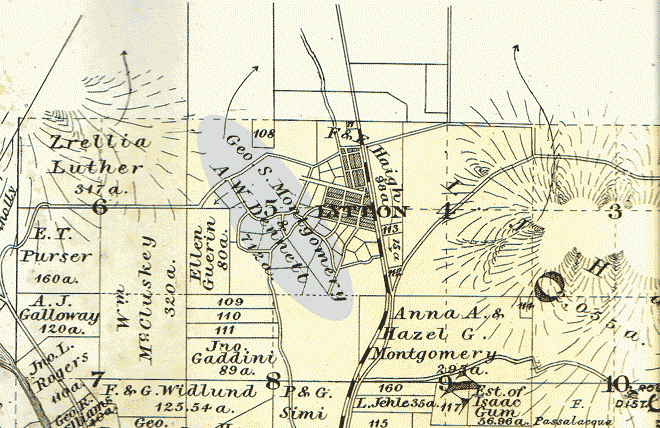
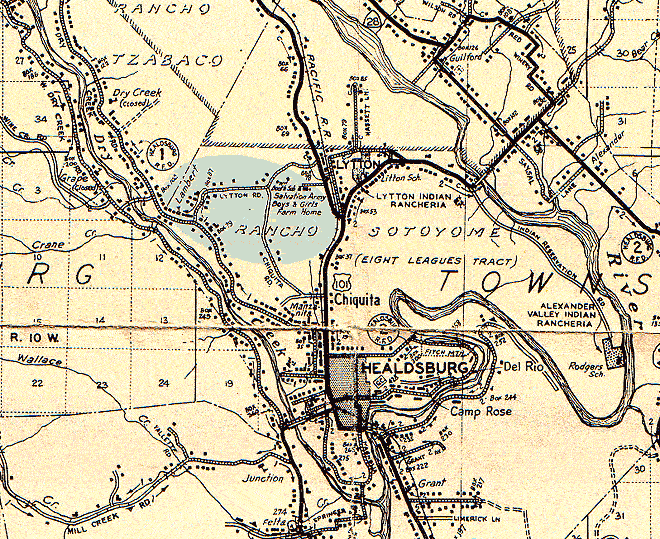
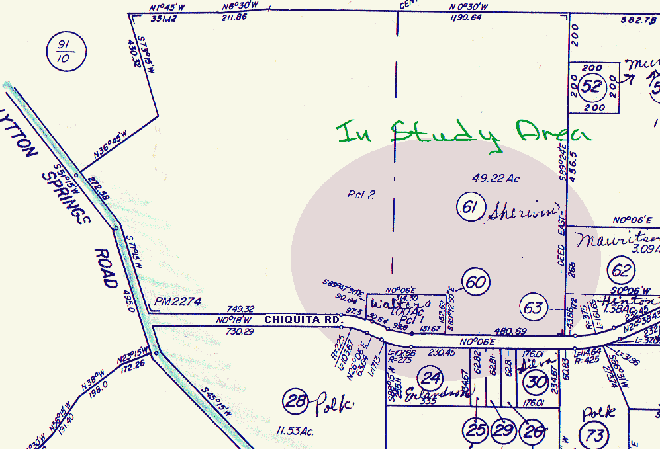
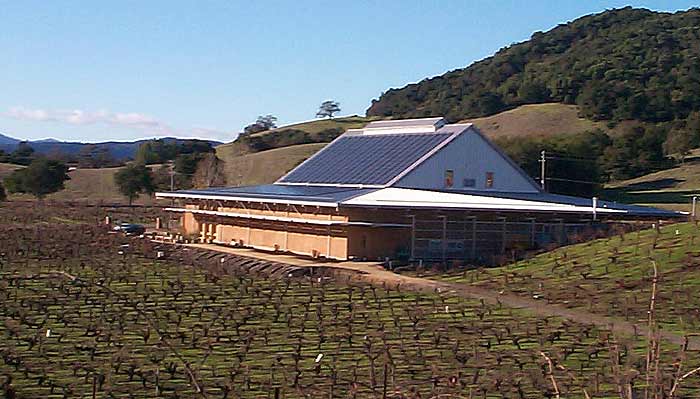
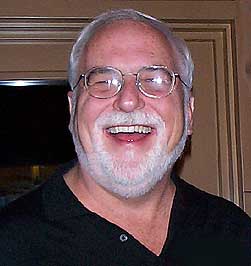

You made some really good points on your post. Definitely worth bookmarking for revisiting. Also, visit my website ZQ3 for content about Podcasting.
Hi. I owned a liquor store in Ojai, CA specializing in great wines in the 80′s and 90′s. The most awesome zin I have ever had was from Lytton Springs 1987. I gave a winemakers dinner back then. The owner was there (I have the pictures) however the winemaker did not come. I cannot remember the wine makers name. Does anyone know who the wine maker was at that time? It seems like he had some affiliation to baseball and he was starting to go out on his own. Would sure like to see how things went for him and if possible try his wine now. Thank you! Lola
This is so true. A smell can sometimes bring you back in time. It’s not just thinking about a certain event or remembering it. It’s more than that. Certain smells can make you feel like you are actually there, in the past.
Keith, can’t answer your question with any authority, but I’m betting that Ridge MB Tasting Room Manager and social media guru Christopher Watkins can. His email address is:
cwatkins@ridgewine.com
Hope this helps!
Cheers,
geo
Hi, I worked in a wine store in the 1980 while I was in college. I remembergoing to winerastings, and how much I LOVED the Lytton Springs wines. I was wondering if someone could answer this for me. I love Ridge wines, and know they purchased Lytton Springs Winery years agoo. But, which of the old Lytton estate wines go into which Ridge Wines? I have been wondering this for years. thanks, Keith
Thanks for the feedback, John. We didn’t get any of the black label magnums you mention, but we were lucky enough to pick up a few 750s; we’ve also been fortunate in having friends who’ve opened bottles for us that go back as far as the ’78 vintage. You’re correct, they don’t make ‘em like they used to; those were old school Zinfandels at their very best!
Cheers,
geo
Agree on the Lytton “original Black Label” zin wholeheartedly…. Ridge LS inherited several magnums of that which were available at the old, tiny tasting room back in 1998-9, and I bought every one I could get my hands on!!! Oh, and they did not last long around the house in Cotati, 92 or 93. I still have an empty Magnum bottle as a reminder and wistful souvenir. The Rosenblum 92 or 94 Brandlin Ranch and the 1992 Ridge ATP Lytton Estate were also very good…but not quite Black Label!! They don’t make them like they used to….either the time, the place, or the wine, but life is still good and precious. Cheers, JH
[...] This post was mentioned on Twitter by Don Coyote, Gang of Pour. Gang of Pour said: Archival revival – "Homage Lytton Springs" by Allan Bree http://bit.ly/cS3Yf6 @RidgeVineyards #wine [...]